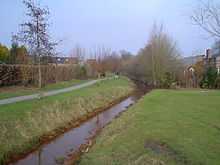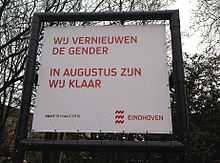Gender (stream)
| Gender | |
|---|---|
 Location of the Gender in the Dutch province of North Brabant. | |
| Origin | De Hees hamlet between Eersel and Steensel |
| Mouth | (historical and projected) confluence with Dommel stream at Eindhoven city centre; (current) Engelsbergenvijver pond, Eindhoven district of Gestel |
| Basin countries | Netherlands |
| Length | 15 km (9.3 mi) |
| Source elevation | 28 m (92 ft) |
| Mouth elevation | 15 m (49 ft) |
The Gender (Dutch pronunciation: [ˈɣɛndər]) is a stream in the Dutch province of North Brabant. It originates in originally marshy flatlands near Steensel and flows through Veldhoven and its eastern district Meerveldhoven in a general east-northeast direction towards Eindhoven.[1]
Flow
The Gender is one of many small streams that drain what once was the marshy heath and moorland of eastern Noord-Brabant and the Kempen plateau. Similar streams include the Dommel, Kleine Dommel, Keersop, Tongelreep, Aa, Binnen-Dieze and Run. All of these streams at one point or other merge to finally form River Dieze in Den Bosch, which in turn flows into River Maas.[1]
Near Eindhoven, the Gender originally flowed just north of the medieval city walls to end in confluence with the Dommel stream, but during the Middle Ages its course was diverted southward through the city centre, to provide the city with freshwater supplies and fire-extinguishing means. By the 19th century, the stretch within the old city had been filled in and the Gender now ended in De Vest, the city moat (which itself was connected to the Dommel).

20th-century channelisation and the emergence of large-scale residential areas in the Gender basin have seen the last stretch before the city centre cut off. In order to regulate water levels of the Dommel and Gender streams, which occasionally threatened to flood Eindhoven's inner city area, a drainage canal (Afwateringskanaal) was dug in the late 1930s to connect the Dommel to the newly constructed Beatrix Canal and so dispose of excess water. Into this canal the Gender now discharges. A further downstream section of the Gender between the canal and the Engelsbergen pond remains, but receives little water of the original stream. Two districts of Eindhoven that are situated on its banks were named after the Gender stream: Genderdal ('Gender Dale') and Genderbeemd ('Gender Meadow').[2]
Nieuwe Gender

In 2005, plans were proposed to have the Gender flow through the Eindhoven city centre once again: the Nieuwe Gender ('New Gender') project. The stream is to flow partially underground, partially above-ground and to discharge into the Dommel near the railway station. As of the summer of 2006, large-scale city centre reconstruction plans have included the implementation of the Nieuwe Gender,[2][3] which is still in progress.

References
- ↑ 1.0 1.1 ter Laan, K. et al. ed. (1942). Van Goor's aardrijkskundig woordenboek van Nederland (in Dutch). Den Haag: Van Goor Zonen.
- ↑ 2.0 2.1 "Samenwerkingsovereenkomst aanleg De Nieuwe Gender" (in Dutch). Gemeente Eindhoven. 2005. Retrieved 24 April 2009.
- ↑ "De Nieuwe Gender" (in Dutch). Gemeente Eindhoven. 2005. Retrieved 24 April 2009.